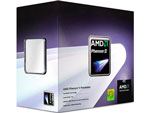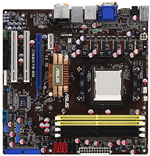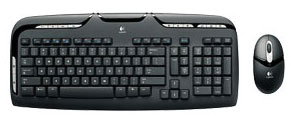AMD HTPC
Everyone asks for HTPC component recommendations, and then when we publish them readers can't wait to throw rocks at our recommendations. Perhaps this is because the HTPC, more than any other computer class, is a very personal machine. It needs to meet the specific needs and demands of the end users, who vary widely in what they plan to do with their new HTPC. So let's first talk about our concept in these two HTPC configurations.
We are assuming the user already has the HDTV (likely) or display he plans to feed, along with a sound system for that HDTV. The motherboards we recommend can reasonably feed audio signals for your Blu-ray movies, but they are not integrated audio amplifiers. Since most end-users are on cable or satellite for TV, we will make no recommendations at all for a TV tuner. Of the many possible uses of an HTPC the great majority of end-users store, play, and stream movies with their HTPC computers. That is mostly what their HTPC systems are used for and that is where we have concentrated our recommendations. In general the processing power in both systems has increased since our December 2009 guide, but costs have gone down a bit.
| AMD HTPC System | ||
| Hardware | Component | Price |
| Processor | MD Phenom II X3 710 (2.6GHzx3, 3x512KB L2, 6MB L3 Cache) |
$119 |
| Cooling | CPU Retail HSF | $- |
| Video | On-Board | $- |
| Motherboard | ASUS M3N78-EM | $90 |
| Memory | 4GB DDR2-800 - GSkill F2-6400CL5D-4GBPQ | $37 |
| Hard Drive | Western Digital Caviar Green WD10EACS 1TB SATA 3.0Gb/s Hard Drive - OEM | $105 |
| Optical Drive | LG BD/HD DVD / 16x DVD+/- RW GGC-H20L - Retail | $110 |
| Audio | On-Board | $- |
| Case | SILVERSTONE Black Aluminum/Steel LC13B-E ATX HTPC Case (After $15 Rebate) | $100 |
| Power Supply | PC Power & Cooling Silencer PPCS500 500W ATX12V / EPS12V SLI Ready CrossFire Ready 80 PLUS Certified Active PFC Power Supply - Retail (after $25 Rebate) | $50 |
| Base System Total | $611 | |
| Keyboard and Mouse | Logitech Cordless Desktop EX110 Black USB RF Wireless Keyboard & Optical Mouse | $30 |
| Operating System | Microsoft Vista Home Premium OEM | $99 |
| Complete System Bottom Line | $740 | |
 |
The CPU chosen for the AMD HTPC computer is the new triple core Phenom II X3 710 with 6MB of L3 cache. You get the expanded processing power of the Phenom II, which is always useful in an HTPC, at the same price as the older Phenom CPU chosen in the December guide. The three CPU cores each run at 2.6GHz, each with a 512KB cache, and a shared 6MB L3 cache - the same L3 cache sized shared on Phenom II quad-core processors. We hesitate to call a Phenom II X3 CPU a low-end chip, but this is certainly the most reasonable Phenom II you can buy. It has plenty of power, however, to drive your AMD HTPC to most anywhere you choose to go.
With DDR2-800 so reasonable these days we equipped the HTPC with 4GB of G.Skill memory. We aren't really interested in overclocking this HTPC (though it's technically still possible), and spending additional money on even higher performance RAM just doesn't make sense. 4GB of memory, however, does make perfect sense in an HTPC box.
 |
The $90 ASUS M3N78-EM is based on the NVIDIA GeForce 8300 chipset. The board features one PCI-E x16 slot, one PCI-E x1 slot, two PCI slots, 8GB memory support, NVIDIA Gigabit LAN, 7.1 HD audio, 12 USB ports, five 3Gb/s SATA ports with RAID support, IEEE 1394a, one eSATA port, HDMI/DVI/VGA output, and full support for the Phenom 140W processors. This board offers overclocking capabilities along with being a top notch HTPC capable board. We highly recommend the GF8200/8300 series for the HTPC market due to hardware accelerated Blu-ray/H.264 playback, multi-channel LPCM output, and very good application performance.
 |
As we discussed in the HTPC introduction, we did not include a TV tuner in the configuration since most end-users are now using their cable and satellite feeds. Few users, therefore, have any real need for a TV tuner card. There's something else to consider in this, and that is the US government mandated deadline to end analog broadcasts (which is now in June), so older/cheaper analog tuner cards are now useless unless you have an analog Cable/Satellite signal. If you truly need a Digital TV tuner, one option that is pretty unique on the TV tuner side is the HD HomeRun from Silicondust USA. This is a dual HDTV tuner/recorder that functions over a network and provides ATSC/QAM support. The price of $169 is more than many other options, but this is arguably a more flexible overall solution - particularly with the mandated move to digital and away from analog.
What's the point of having an HTPC if you don't have a lot of storage space? To that end, we selected a newly affordable 1TB (1000GB) Western Digital Caviar Green WD10EACS SATA hard drive at just $105. The WD Green is a variable speed energy saving design that we found to be among the quietest drives we have ever evaluated. For an HTPC, quiet operation is paramount and this WD Green will not disappoint. The WD Green is a bit slower than true 7200RPM 1TB drives, but the real performance difference is very minor. Another excellent HD option is the Seagate Barracuda 7200.11 ST31000333AS 7200RPM 1TB at $110. Performance of this 1TB drive has been exemplary in early testing at AnandTech, and the drive has proved to be reasonably quiet. Seagate also makes a super-reliable 1TB drive optimized for video storage and retrieval called the Seagate SV35.3 ST31000340SV 1TB at $150. This "video" Seagate features 24x7 reliability with > 1 million hours MTBF and improved read/write reliability. For those willing to pay the small premium the "video" Seagate would be a good alternate choice.
 |
The optical drive is certainly an upgrade to the entry and budget systems since a reasonable HTPC requires Blu-ray playback capabilities. The LG Black 6X Blu-ray SATA fits the bill without breaking the bank. It provides 6X Blu-ray playback and the fastest recording and playback of DVD and CD media. The current price is around $110, but this drive sometimes goes on sale for $100 so look out for specials. There are also Blu-ray options under $100 from Lite-On and a 6X Blu-ray player at $105. We do not have much experience with this Lite-On drive, but Lite-On drives in the past have proved reliable. That would make the Lite-On Black 6X Blu-ray SATA a more reasonably priced alternative where every penny counts.
 |
Our choice for an HTPC case is the audio component look in the Silverstone LC13B-E, which is an extremely flexible design with two silent fans and silent power when combined with the PC Power and Cooling 500W Silencer power supply. This solid Silverstone case can handle either ATX or Micro ATX motherboards, with space for four internal hard drives in addition to two 5.25" External bays and two 3.5" external bays. If your plans for your HTPC include lots of comportments and storage the Silverstone is an excellent choice. If you prefer a small cube case the Lian Li PC-V350B is a gem of a small black aluminum case. The Lian Li is our choice for the Intel HTPC system on the next page, and you can find more information on that case there.
 |
Since most will place their HTPC near their HDTV or big screen monitor, a wired keyboard and mouse are not really very useful in most setups. Control is more often from across the room, so a wireless RF Logitech keyboard and mouse were selected. At just $25 for the pair, the Logitech Cordless Desktop EX110 wireless keyboard and mouse is a great value. This is also the HTPC preferred RF wireless set, which does not require "line of sight" that is needed for IR wireless.
The final price of the AMD HTPC comes to just $740. That has to be considered a bargain considering the triple core Phenom II CPU, 4GB of memory, and 1TB hard drive all housed in a quiet Silverstone HTPC case with a PC Power and Cooling Silencer 500W PSU. You can certainly spend even less on a basic HTPC box, but we doubt you can build a more powerful or quiet system for the same money.










66 Comments
View All Comments
v12v12 - Wednesday, March 18, 2009 - link
I agree most of these posts are the nerds-nit-pick special! I'm sorry but if you're whining about $15 here and $20, get a clue and get a REAL JOB or start saving/studying for certs/school and make some real money.This shoe-string budget crap, for a so-called "gamer" box is plain stupidity. If you're hurting over $600-800 MAX limit, sounds like you have your financial PRIORITIES out of whack! Nobody is "gaming" for long with a $600 box. It's a fool's investment and will have you stuck with a sub-par performing machine, rapidly. Oh and don't even think about resale, you're stuck with the low-end junk.
While mirroring the car market: UPSCALE cars/PC builds lose a small percentage of value as soon as you buy them, BUT they hold top value over the coming months Vs this low-mid-level junk that immediately loses an chance of resale value. Have you seen how many stupid people are on Ebay that overbid even for those relic 8800s?!
Who's going to buy your used, non-warranted (many manu's do require proof of purchase these days) 2nd rate card for ~$30 less than RETAIL? Pawning that off to ebay noobs is your only hope to recoupe your losses. Be smart people.
If you're maxing out around $600 = STOP and rethink your finances... $800? Might as well save and get an Icore. Geesh, oh and don't forget about TAXES + initial cost of hardware lol. Not to mention if something goes wrong and you have to RMA = how you gonna afford S/H if you can barely afford a paltry $600-800?
Flame time...
nubie - Tuesday, March 17, 2009 - link
I did get an e5200, for $59.But the motherboard I chose was not using single channel ram, or onboard video. I got an 8600GTS (the GTS is important, it has much more memory bandwidth - 2000mhz DDR3) for $43.
I would like to note that new systems with any sort of budget should be built with a quad-core (unless you need that 4.0ghz clocked Wolfdale for gaming of course.) The Q6600 is only $160 on ebay, and it is a really solid performer.
Kudos to showing how to build a system for people new to the task (and it is infinitely better than letting the newbs pick their own stuff, like 3GB of ram and a 9800pro for example.)
I guess ultimate hard-core system building isn't your cup of tea, maybe we need a "Reader's Rigs" section where we can duke it out with budget builds to see what can really be done. (I would cheat, there are P6N OEM boards for $40 on ebay, and MSI should RMA them for functionality with 45nm processors, it already took a Celeron 440 to 3.33ghz without even a voltage bump!! Ironically Speedstep now starts at the 2.0ghz rating of the chip, so it cycles up less than before.)
Knowname - Tuesday, March 17, 2009 - link
The only future proof quad cores right now are the i7's, even the Phenom 2's will choke under a very taxing 4-core+ program. The proof is in the cache, where even the Phenom's 6mb (shared) is just too little for a fully multicore aware program. It is for this reason that the Core2Quad's 2mb or 4mb cache per core is just TERRIBLE future proofing.Then again, you have to ask yourself... just how much future proofing do I need? When we are in an era of replacing ENTIRE computers every 9 months.
Knowname - Tuesday, March 17, 2009 - link
well my point was it may actually be better for somebody looking to future proof at these prices to buy a e8xxx rather than a q6xxx... JMO.nubie - Wednesday, March 18, 2009 - link
Well, for these prices I would recommend that somebody wait for i7.If they are really on a budget there are 650i OEM motherboards for $40 on ebay, and look for a good deal on a Wolfdale ~$60-70, or overclock the heck out of a Celeron 430/440 (my last two were fine at 3 and 3.33ghz respectively.)
My definition of budget is being out of steady work for ~3 years, so the value for money needs to be very high, and the e5200 and Core2 Celeron are very good in that regard, with 70% overclocks the norm.
My budget systems come in around the $300-350 mark, not the $500+ segment, and yet I would say that they offer the same functionality for gaming and general use (and as I said, I would go Q6600 if I could, probably will when everyone moves to i7 and the prices drop below $100)
7Enigma - Tuesday, March 17, 2009 - link
Great deal I saw on Fatwallet the other day if you are a student (or know someone whom is). This would drop another $35 bucks which would allow for some much needed flexibility especially on the entry-level systems where that difference is ~7% of the build price.Oh to be a student again.....
http://www.microsoft.com/windows/products/windowsv...">http://www.microsoft.com/windows/products/windowsv...
7Enigma - Tuesday, March 17, 2009 - link
Wanted to mention that page also includes Office Ultimate 2007 for $60 if you are an active student. Not bad for someone who needs Office (I personally use OpenOffice).*Seems like the Vista Ultimate might be an upgrade version and not the full version. It's difficult to confirm as the main page that is linked doesn't mention which version but if you click on it it shows upgrade with sp1. Someone less of a hot deal if it's the upgrade only.
7Enigma - Tuesday, March 17, 2009 - link
Anand see if your weight in the tech industry will allow you to aquire for testing one of these puppies:http://www.dailytech.com/Fusionio+Claims+Worlds+Fa...">http://www.dailytech.com/Fusionio+Claim...lds+Fast...
I'd love to see it put through its paces, even though it is in a completely different class ($5000 for lowest model).
scwtlover - Monday, March 16, 2009 - link
For the entry-level AMD system, you recommend G.Skill 800-DDR2 RAM at $37. It's timings are 5-5-5-15 and 1.8V, but it does not come with a heat-spreader. Should we infer that a heat-spreader is unnecessary?mushkin 1.8V memory, with 5-4-4-12 timings and a heat-spreader is available, after rebate, for only $3 more.
And, how significant is 1.8V? At 800-DDR2 Newegg sells OCZ with a heat-spreader and 5-4-4-15 timings, but 2.1V. It's $24 after rebate. Corsair's offering, after rebate, is only $20. It has heat-spreaders, and is 1.9V. The timings are 5-5-5-18? How significant is 12 v. 15 v. 18?
If we look at 1066 DDR2 RAM, the OCZ sticks you recommend cost $28, after rebate. You advise: "Just be sure to look for RAM with better timings if you can afford it." The OCZ is CAS 7, with 7-7-7-20 at 2.0V. For $30, after rebate, Newegg sells OCZ2P10664GK. It's CAS 5, with 5-5-5-18 timings at 2.2V. For $8 more than that, you can get the same RAM plus a bundled XTC memory cooler. How important is voltage versus timings? For $34, that is, $6 more than the OCZ, Newegg sells OCZ Reaper with 5-5-5-18 timings at 2.1V
Wesley Fink - Monday, March 16, 2009 - link
Traditional "Plate stuck on each side" heatspreaders do almost nothing to cool the ram. in fact sometimes they hold in heat and are actually worse than no heatspreader at all. Some more exotic HS designs used in more expensive RAM that is run at higher voltages sometimes do help cool the RAM.The OCZ is DDR2-1066 with slower timings and the 5-5-5 and faster is DDR2-800. The same 7-7-7 1066 memory often runds fine at 5-5-5 at DDR2-800. Higher speed usually means slower timings. If you can find faster RAM like DDR2-1066 at CAS 5 at a similar price then buy it.
As I said in the article quality RAM at the same speed can be selected from any of the major memory providers. Comparing two at the same price look at highest speed combined with reasonable timings. If the two memories are the same price and the same speed then timings (and warranty support) should be your main considerations.
We try to select reasonable choices we have personal experience in using at AT. But there are many rebates in memory right now - and they change daily. You need to be flexible if you are looking for memory that is the best value.